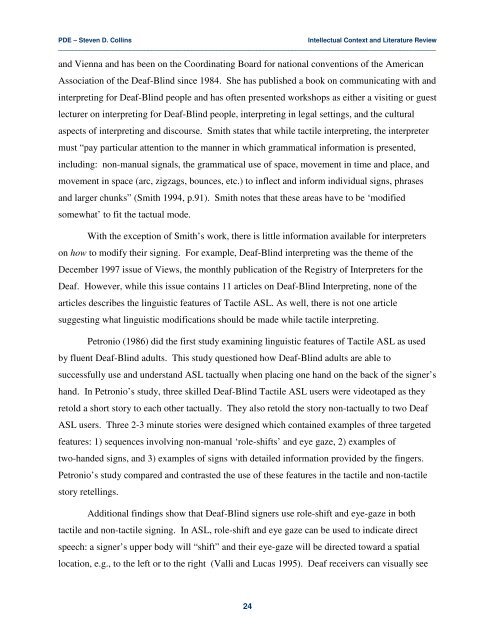Adverbial Morphemes in Tactile ASL - Gallaudet University
Adverbial Morphemes in Tactile ASL - Gallaudet University
Adverbial Morphemes in Tactile ASL - Gallaudet University
Create successful ePaper yourself
Turn your PDF publications into a flip-book with our unique Google optimized e-Paper software.
PDE – Steven D. Coll<strong>in</strong>s<br />
Intellectual Context and Literature Review<br />
_________________________________________________________________________________________________________<br />
and Vienna and has been on the Coord<strong>in</strong>at<strong>in</strong>g Board for national conventions of the American<br />
Association of the Deaf-Bl<strong>in</strong>d s<strong>in</strong>ce 1984. She has published a book on communicat<strong>in</strong>g with and<br />
<strong>in</strong>terpret<strong>in</strong>g for Deaf-Bl<strong>in</strong>d people and has often presented workshops as either a visit<strong>in</strong>g or guest<br />
lecturer on <strong>in</strong>terpret<strong>in</strong>g for Deaf-Bl<strong>in</strong>d people, <strong>in</strong>terpret<strong>in</strong>g <strong>in</strong> legal sett<strong>in</strong>gs, and the cultural<br />
aspects of <strong>in</strong>terpret<strong>in</strong>g and discourse. Smith states that while tactile <strong>in</strong>terpret<strong>in</strong>g, the <strong>in</strong>terpreter<br />
must “pay particular attention to the manner <strong>in</strong> which grammatical <strong>in</strong>formation is presented,<br />
<strong>in</strong>clud<strong>in</strong>g: non-manual signals, the grammatical use of space, movement <strong>in</strong> time and place, and<br />
movement <strong>in</strong> space (arc, zigzags, bounces, etc.) to <strong>in</strong>flect and <strong>in</strong>form <strong>in</strong>dividual signs, phrases<br />
and larger chunks” (Smith 1994, p.91). Smith notes that these areas have to be ‘modified<br />
somewhat’ to fit the tactual mode.<br />
With the exception of Smith’s work, there is little <strong>in</strong>formation available for <strong>in</strong>terpreters<br />
on how to modify their sign<strong>in</strong>g. For example, Deaf-Bl<strong>in</strong>d <strong>in</strong>terpret<strong>in</strong>g was the theme of the<br />
December 1997 issue of Views, the monthly publication of the Registry of Interpreters for the<br />
Deaf. However, while this issue conta<strong>in</strong>s 11 articles on Deaf-Bl<strong>in</strong>d Interpret<strong>in</strong>g, none of the<br />
articles describes the l<strong>in</strong>guistic features of <strong>Tactile</strong> <strong>ASL</strong>. As well, there is not one article<br />
suggest<strong>in</strong>g what l<strong>in</strong>guistic modifications should be made while tactile <strong>in</strong>terpret<strong>in</strong>g.<br />
Petronio (1986) did the first study exam<strong>in</strong><strong>in</strong>g l<strong>in</strong>guistic features of <strong>Tactile</strong> <strong>ASL</strong> as used<br />
by fluent Deaf-Bl<strong>in</strong>d adults. This study questioned how Deaf-Bl<strong>in</strong>d adults are able to<br />
successfully use and understand <strong>ASL</strong> tactually when plac<strong>in</strong>g one hand on the back of the signer’s<br />
hand. In Petronio’s study, three skilled Deaf-Bl<strong>in</strong>d <strong>Tactile</strong> <strong>ASL</strong> users were videotaped as they<br />
retold a short story to each other tactually. They also retold the story non-tactually to two Deaf<br />
<strong>ASL</strong> users. Three 2-3 m<strong>in</strong>ute stories were designed which conta<strong>in</strong>ed examples of three targeted<br />
features: 1) sequences <strong>in</strong>volv<strong>in</strong>g non-manual ‘role-shifts’ and eye gaze, 2) examples of<br />
two-handed signs, and 3) examples of signs with detailed <strong>in</strong>formation provided by the f<strong>in</strong>gers.<br />
Petronio’s study compared and contrasted the use of these features <strong>in</strong> the tactile and non-tactile<br />
story retell<strong>in</strong>gs.<br />
Additional f<strong>in</strong>d<strong>in</strong>gs show that Deaf-Bl<strong>in</strong>d signers use role-shift and eye-gaze <strong>in</strong> both<br />
tactile and non-tactile sign<strong>in</strong>g. In <strong>ASL</strong>, role-shift and eye gaze can be used to <strong>in</strong>dicate direct<br />
speech: a signer’s upper body will “shift” and their eye-gaze will be directed toward a spatial<br />
location, e.g., to the left or to the right (Valli and Lucas 1995). Deaf receivers can visually see<br />
24
















